9. Universal Islands of Adventure (1999)
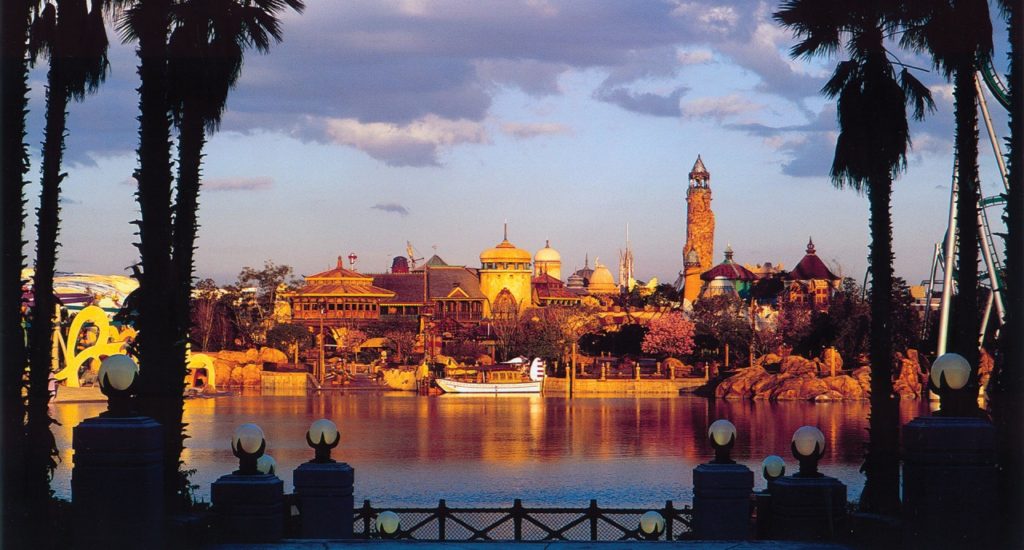
Universal Islands of Adventure is a park with substantial steadiness thanks to its founding ethos: that it leaves flavor-of-the-week movies to its older sister, and instead features something much less fleeting – stories – as its centering spirit. The result is a lineup that’s entirely IP-centered, but timeless and intergenerational. (As we often say, a glimpse at Universal Studios Beijing shows us what an Islands of Adventure designed today would probably look like – Transformers instead of Marvel, Minions in place of Seuss, Jurassic World instead of the literary Jurassic Park, and Kung Fu Panda in place of Popeye.)
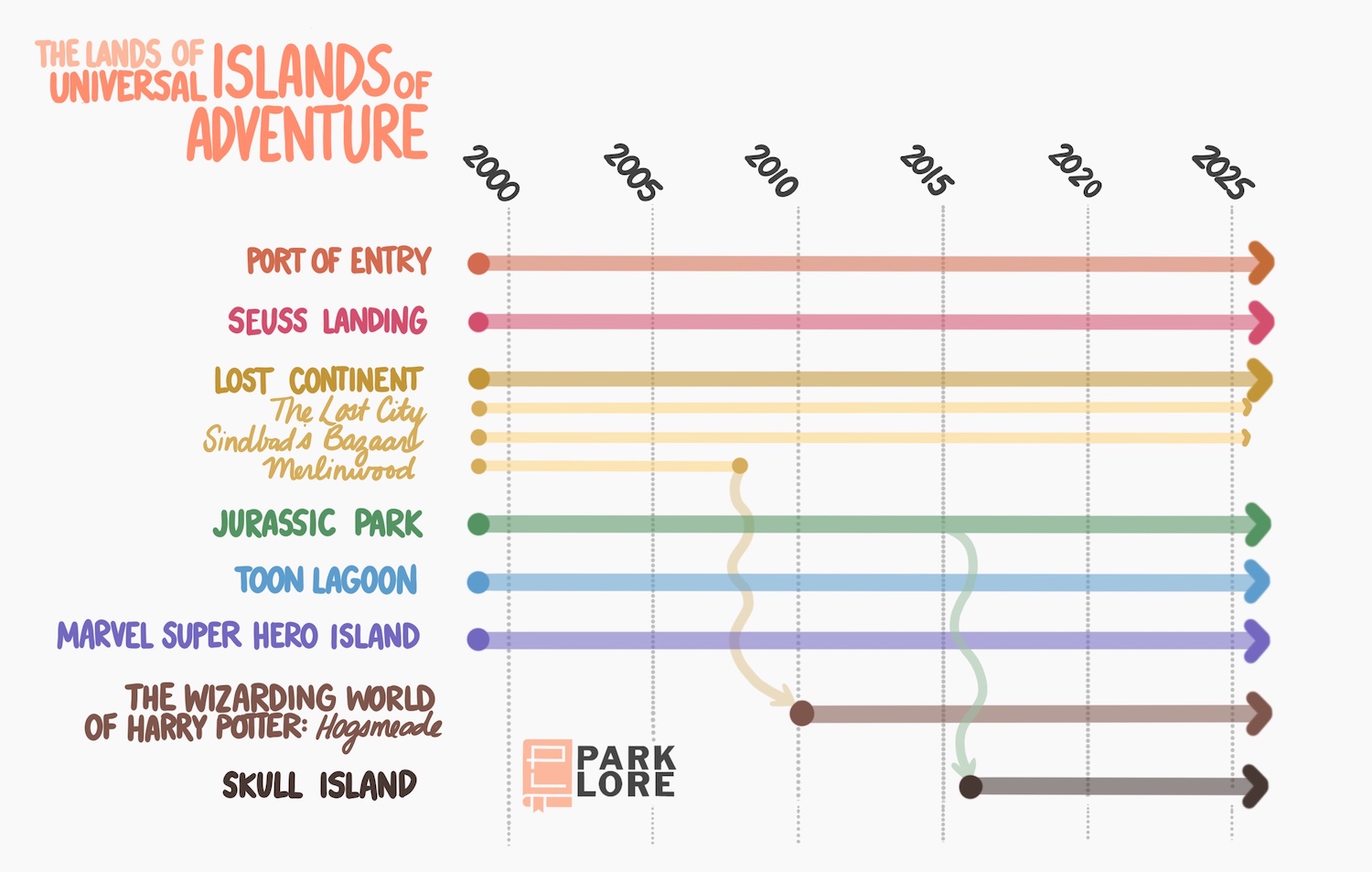
In a “zoomed out” sense, there have only been a few major changes to the lineup of the park’s lands. The Lost Continent ceded one of its three literary realms to create The Wizarding World of Harry Potter: Hogsmeade. Then, an expansion pad that was technically set aside for Jurassic Park was annexed to create the park’s only “inland” island, Skull Island – really just a segment of midway serving as the entrance to the Reign of Kong ride. It’s not a great ride, and Kong doesn’t really fit the “vibe” of the otherwise-storybook park, which is why my Build-Out of Islands of Adventure (one of my favorite projects ever) uses the space for a Jurassic expansion instead!
There are no doubt machinations behind the scenes to figure out what’s next for Islands of Adventure… rumors have consistently suggested, for example, that The Kingdom of Hyrule from Nintendo’s The Legend of Zelda would be a shoe-in for the now-vacant remains of the Lost Continent’s vestigial parts, or that Universal may eye something new to take over Toon Lagoon, or that Disney could buy back the rights to Marvel in Florida theme parks, leaving Universal to reinvent their existing superhero land. But more than anything, we can hope and pray that Universal knows to keep this park timeless. Minions, Transformers, and Trolls are really best left to studio parks…
10. Disney California Adventure (2001)
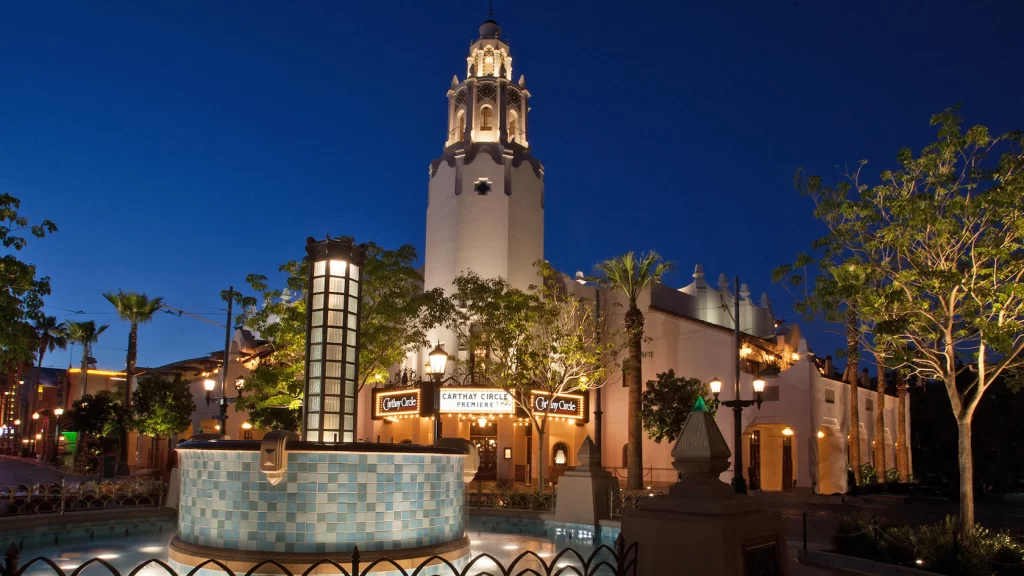
For me, this is the Landline that “started it all,” created to tell the story of the lifelong transformation of Disney California Adventure. (Thanks to @sammyruntz on Bluesky who suggested turning it into a series!) The first of a series of three under-built, under-funded New Millennium parks, California Adventure’s “landline” will become a norm for the next few entries – lots and lots of chaos, clutter, “undos” and “redos.”
Designed to be very different from the timeless, historic, and romantic Disneyland next door, California Adventure opened in 2001 touting an “MTV attitude,” stylized as an oversaturated, post-modern salute to the Golden State that bordered on a spoof. “Too much California, not enough Disney,” it opened with just four “districts” – Sunshine Plaza, The Golden State, Hollywood Pictures Backlot, and Paradise Pier. From go, the park was heavily criticized for having very few Disney quality rides, practically no Disney characters, and almost nothing for families to do. “a bug’s land” opened in 2002 as a quick-fix solution to stem the flow of families out of the new park.
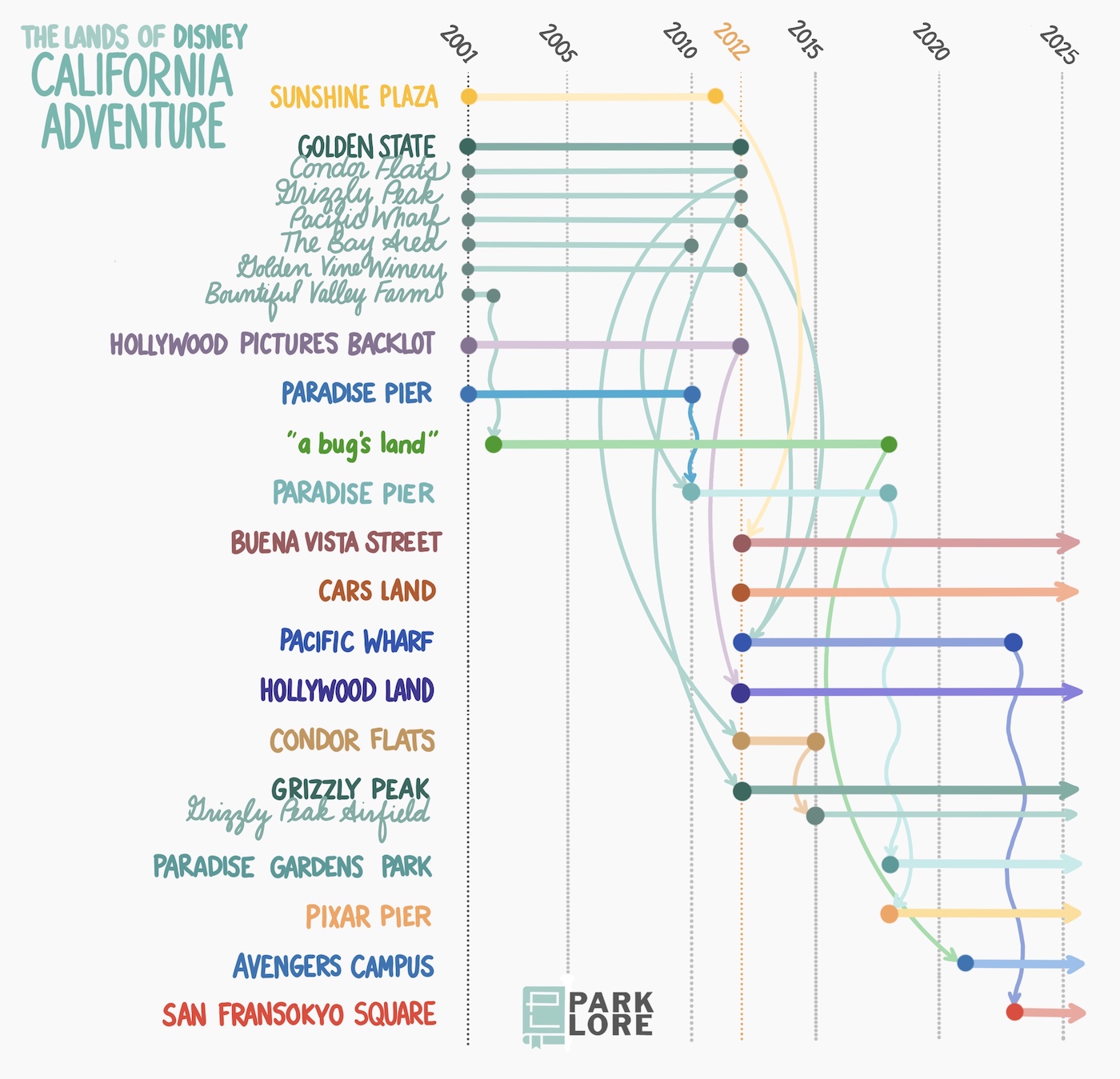
But of course, California Adventure’s story became very interesting in 2007 when – in an unprecedented move – then-new CEO Bob Iger announced a five year, billion-dollar reinvestment that would recast the park in the same style as Disneyland: historic, reverent, idealized, and filled with character. In a first ever move, the park had an official re-opening and second dedication on June 15, 2012, with eight lands – the same number as Disneyland – including the enviable and exceptional Buena Vista Street and Cars Land..
Of course, as those who’ve read our epic three part retelling of the park’s story will know, the decade since has weirdly seen Imagineering undo much of the placemaking, storytelling, and California-focus they rolled out in 2012. The result is a park that’s arguably “too much Disney, not enough California,” anchored by the “cute but dumb” Pixar Pier, the anchor-less Avengers Campus, and the label-slapped San Fransokyo Square. Who could’ve guessed – it turns out that stickering Disney, Pixar, and Marvel IPs across the park has had virtually zero impact on the park’s attendance. Oops!
Disney’s clearly hoping that a big budget, high quality expansion (something the park hasn’t had since Cars Land) will do the trick. That’ll be by way of a West Coast version of everyone’s favorite region of California – Pandora: The World of Avatar – announced in 2024.
11. Tokyo DisneySea (2001)
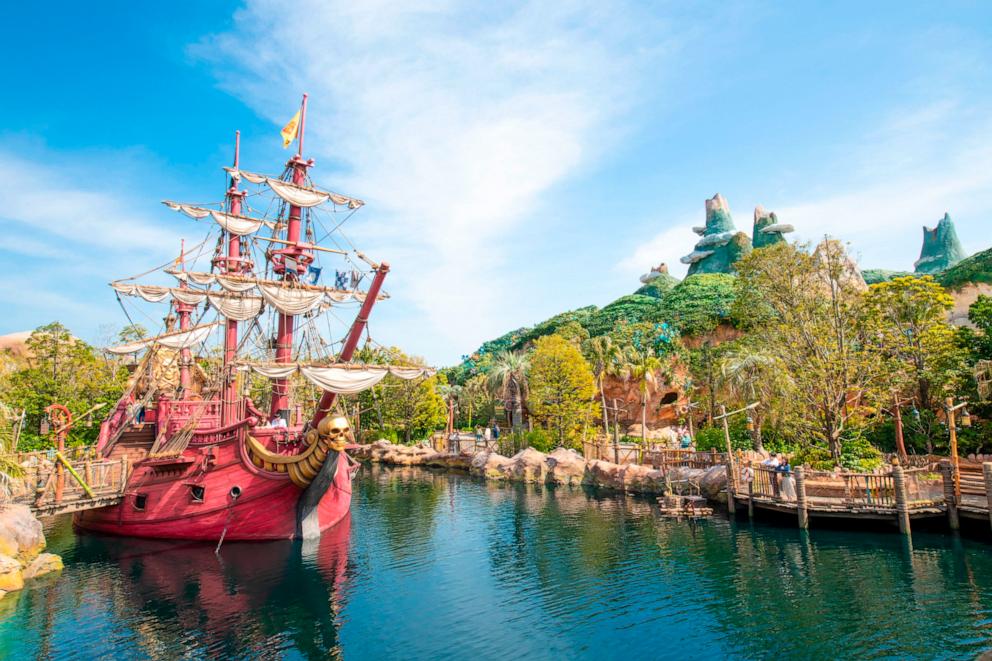
As theme park fans know all too well, Tokyo DisneySea is a vast divergence from what other Disney Parks of the era were looking like and going through. That’s again because of the Oriental Land Company (OLC) who owns and operates the resort somewhat like a franchisee, paying big licensing bucks to Disney and hiring Walt Disney Imagineering as a contractor to develop its rides and attractions.
Considered by many to be the best theme park on Earth, DisneySea opened with the concept of containing seven “ports of call” for each of the seven seas; each exploring a particular region’s relationship with water. Guests enter via the Italian-themed Mediterranean Harbor, a seaside village reigned over by the Hotel MiraCosta. American Waterfront recreates a New York City of the 1910s, including a docked ocean liner. There’s Port Discovery (a sort of “Tomorrowland” for the park) then Lost River Delta (a South American archaeological site), Mermaid Lagoon (an indoor “Fantasyland”), and Arabian Coast (lightly themed to Aladdin).
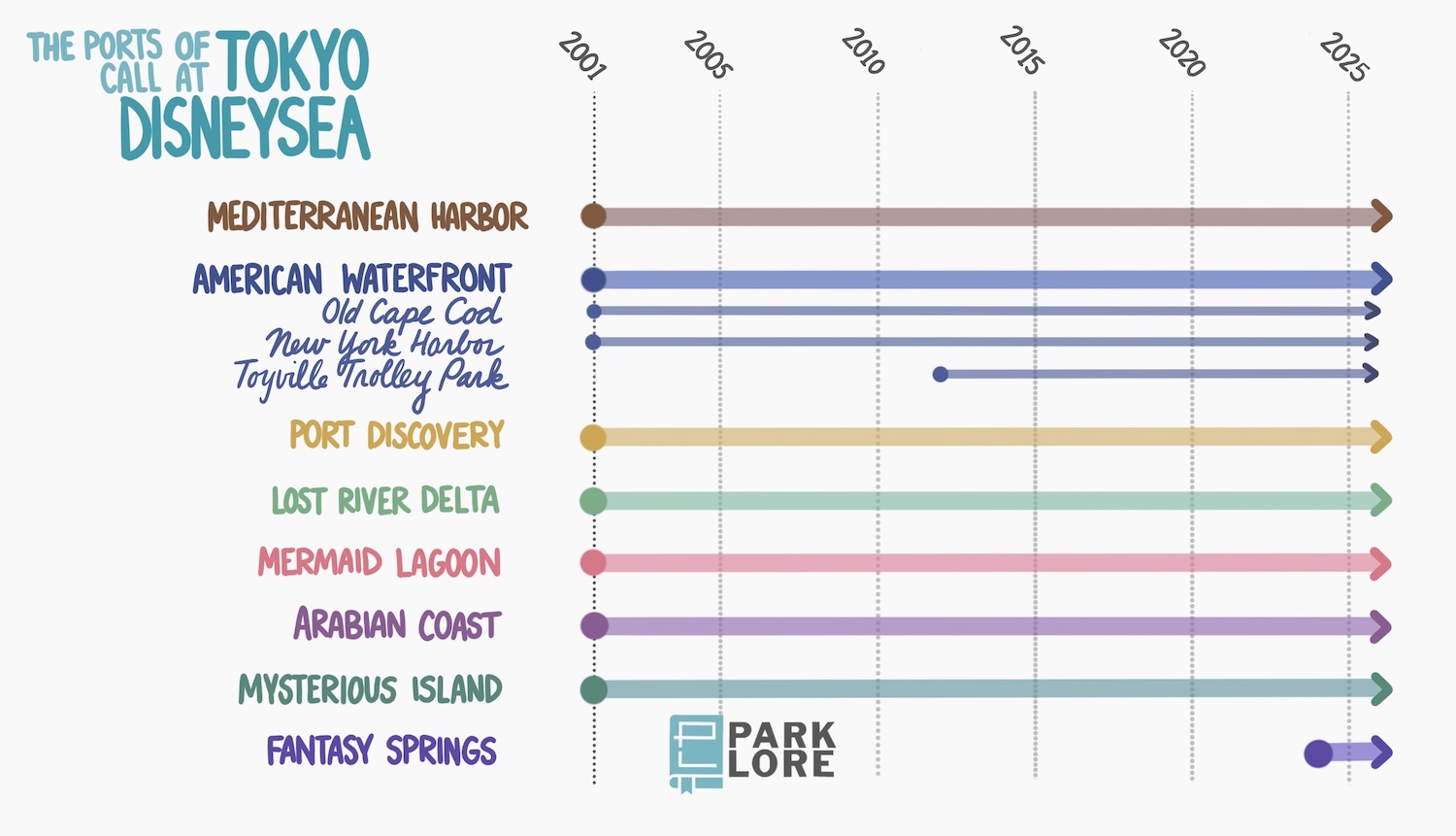
Of course, bar none, the park’s highlight has always been Mysterious Island – a land fully contained within the collapsed caldera of the park’s icon, Mount Prometheus. Themed to the science-fantasy adventure novels of Jules Verne and his Captain Nemo character, the land is entirely contained to suspended catwalks and bored tunnels through the volcano – an absolute icon.
Showing all the stability of a Castle Park (which, as you’ve seen, is very, very rare among non-Castle parks), DisneySea has never lost a land. Of course, it’s only ever gained one, too. After briefly announcing then retracting plans for a Frozen themed land, in 2018 the park shifted its focus toward a much larger storybook-inspired land, Fantasy Springs, which opened in 2024. The port is made of three sub-sections dedicated to Frozen, Tangled, and Peter Pan, respectively, and each – yes, each – has its own E-Ticket attraction, representing a massive growth for the park in square footage, ride count, dark ride count, and E-Ticket count.
12. Walt Disney Studios Paris

You don’t have to be part of the Disney Parks fandom for long before you hear the jaw-dropping story of the Declassified Disaster: Walt Disney Studios Park. Opened in 2002 as a contractually-obligated second theme park for Disneyland Paris, Walt Disney Studios was (and two decades later, remains) genuinely embarrassing. It opened with just three rides (a copy of Rock ‘n’ Roller Coaster, a Magic Carpets spinner, and a “Studio tram tour” with even less reason to exist than Orlando’s) and has grown in fits and starts since, up to and including a multi-billion dollar expansion it’s now in the midst of.
It’s nearly impossible to trace the definitive lineup of lands that have called Walt Disney Studios Park in Paris home, because this park, too, has undergone waves of expansion and contraction, upgrading and downgrading spaces to and from full “land” status whenever it’s convenient. What officially “counts” as a standalone land at any given time is fairly flexible. So even though this park is undergoing its own “DCA”-style reimagining, it’s far less tethered and far more random, trying to make sense of yet another outdated “studio” park that wasn’t really designed with a long term plan in mind.
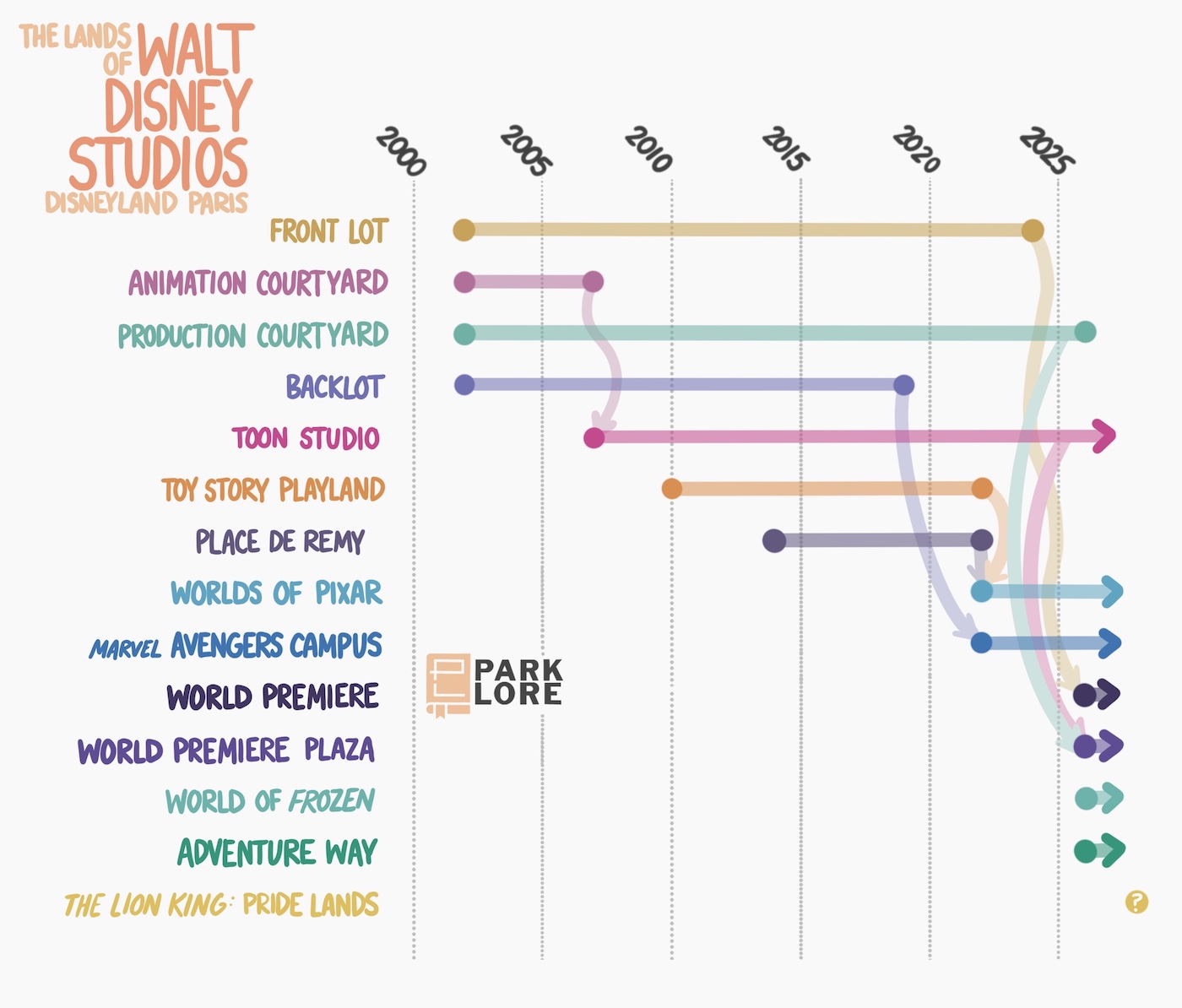
To make a long story short, the park opened with four “Lots” – the Front Lot, Animation Courtyard, Production Courtyard, and the Backlot. Mercifully, none remain, having been absorbed and expunged through various quick-fix attempts to make the park worth visiting. (Let’s put it this way: you don’t have to pay extra on a multi-day ticket to Park Hop at Disneyland Paris.)
Currently, the park’s latest vision is basically to follow Hollywood Studios’ path: to keep its reliance on Hollywood as an opening act, but then diverge into immersive “worlds” dedicated to Disney intellectual property. Unfortunately, it’s all with none of the budget and ambition sent to Orlando. In 2026, Walt Disney Studios will officially be renamed Disney Adventure World, which is – frankly – a pretty good representation of how generic and directionless the park will continue to be.
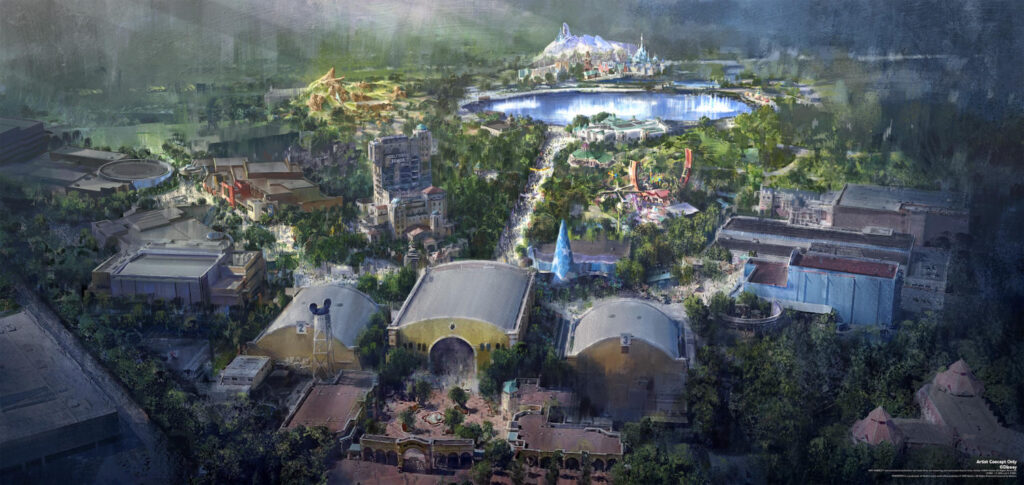
When it officially “re-opens,” it looks like it’ll be with an unusual set up that kinda sorta tries to do what Universal Epic Universe does (immersive, cinematic, IP “worlds”), but does it really inelegantly by the need to also salvage a bunch of soundstages, a fundamentally flawed layout, and a ton of faux “studio” infrastructure that can’t really be disguised or corrected without starting from scratch. (It also does the new EPCOT thing of thinking that you can just put the word “World” in front of something that it’ll be clever or cohesive.)
Guests will enter through World Premiere (the old welcome plaza and enclosed “Studio One”), which will let out into World Premiere Plaza (approximately the old Production Courtyard, but now with trees). To the right will be Toon Studio (an Aladdin spinner, a Cars spinner, and a Finding Nemo coaster in a soundstage), not to be confused with Worlds of Pixar (roughly cramming together the Ratatouille and Toy Story lands). To the left is Marvel Avengers Campus (where the “Backlot” once was).
The park’s real expansion takes place in previously-unused space “behind” the existing footprint. From the entrance, a new wooded mall called Adventure Way will lead straight back to a new lagoon called “Adventure Bay.” The idea is that several IP lands could eventually surround it, but only one – World of Frozen – will be ready for 2026. At least one other pad will be activated by a Lion King mini-land… eventually!
When all is said and done, the park’s very expensive reimagining will apparently yield a re-themed Rock ‘n’ Roller Coaster, Web Slingers (copied from California Adventure), a Ratatouille dark ride (identical to EPCOT’s), Frozen Ever After (also already at EPCOT), and eventually, a unique Lion King flume ride. It seems somewhat doubtful the sum total of those additions will suddenly make Walt Disn– er, Disney Adventure World into a desirable, destination park. But we’ll see…


